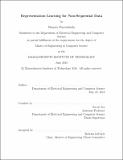Representation learning for non-sequential data
Author(s)
Parvathala, Rajeev (Rajeev Krishna)
DownloadFull printable version (817.1Kb)
Other Contributors
Massachusetts Institute of Technology. Department of Electrical Engineering and Computer Science.
Advisor
Suvrit Sra.
Terms of use
Metadata
Show full item recordAbstract
In this thesis, we design and implement new models to learn representations for sets and graphs. Typically, data collections in machine learning problems are structured as arrays or sequences, with sequential relationships between successive elements. Sets and graphs both break this common mold of data collections that have been extensively studied in the machine learning community. First, we formulate a new method for performing diverse subset selection using a neural set function approximation method. This method relies on the deep sets idea, which says that any set function s(X) has a universal approximator of the form f([sigma]x[xi]X [phi](x)). Second, we design a new variational autoencoding model for highly structured, sparse graphs, such as chemical molecules. This method uses the graphon, a probabilistic graphical model from mathematics, as inspiration for the decoder. Furthermore, an adversary is employed to force the distribution of vertex encodings to follow a target distribution, so that new graphs can be generated by sampling from this target distribution. Finally, we develop a new framework for performing encoding of graphs in a hierarchical manner. This approach partitions an input graph into multiple connected subgraphs, and creates a new graph where each node represents one such subgraph. This allows the model to learn a higher level representation for graphs, and increases robustness of graphical encoding to varying graph input sizes.
Description
Thesis: M. Eng., Massachusetts Institute of Technology, Department of Electrical Engineering and Computer Science, 2018. This electronic version was submitted by the student author. The certified thesis is available in the Institute Archives and Special Collections. Cataloged from student-submitted PDF version of thesis. Includes bibliographical references (pages 85-90).
Date issued
2018Department
Massachusetts Institute of Technology. Department of Electrical Engineering and Computer SciencePublisher
Massachusetts Institute of Technology
Keywords
Electrical Engineering and Computer Science.